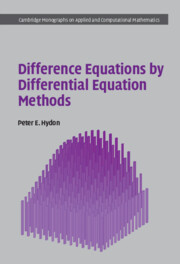Preface
Published online by Cambridge University Press: 05 August 2014
Summary
Difference equations are prevalent in mathematics, occurring in areas as disparate as number theory, control theory and integrable systems theory. They arise as mathematical models of discrete processes, as interesting dynamical systems, and as finite difference approximations to differential equations. Finite difference methods exploit the fact that differential calculus is a limit of the calculus of finite differences. It is natural to take this observation a step further and ask whether differential and difference equations share any common features. In particular, can they be solved by the same (or similar) methods?
Just over twenty years ago, a leading numerical analyst summarized the state of the art as follows: problems involving difference equations are an order of magnitude harder than their counterparts for differential equations. There were two major exceptions to this general rule. Linear ordinary difference equations behave similarly to their continuous counterparts. (Indeed, most of the best-known texts on difference equations deal mainly with linear and linearizable problems.) Discrete integrable systems are nonlinear, but have some underlying linear structures; they have much in common with continuous integrable systems, together with some interesting extra features.
- Type
- Chapter
- Information
- Difference Equations by Differential Equation Methods , pp. xi - xivPublisher: Cambridge University PressPrint publication year: 2014

